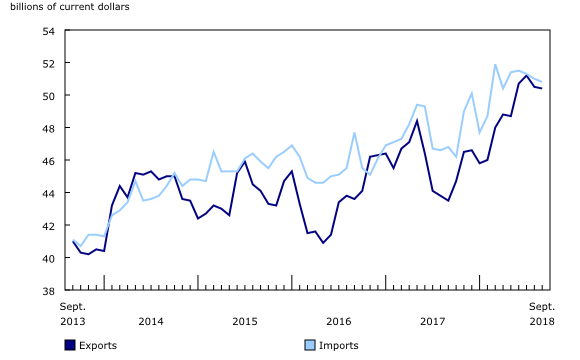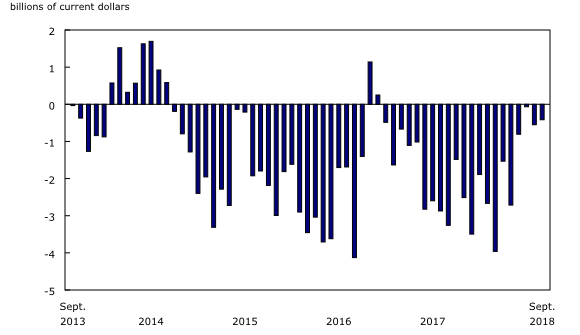Canadian international merchandise trade, September 2018
Archived Content
Information identified as archived is provided for reference, research or recordkeeping purposes. It is not subject to the Government of Canada Web Standards and has not been altered or updated since it was archived. Please "contact us" to request a format other than those available.
Released: 2018-11-02
Canada's merchandise trade deficit with the world narrowed to $416 million in September from $551 million in August. Imports fell 0.4%, while exports edged down 0.2%.
Owing to a large upward revision to imports for the August reference month, the trade balance originally reported as a $526 million trade surplus last month is now showing a $551 million deficit. Most of this revision was due to the import of three high value ships, which were reported after the publication of August data. Although late documentation of high-value transactions is common for trade data, the aggregate value these ships represent is infrequently received in late transactions.
Decrease in imports
Total imports fell 0.4% to $50.8 billion in September, despite gains in 6 of 11 product sections. Import volumes decreased 1.5%, while prices rose 1.1%. Aircraft and other transportation equipment and parts (mostly ships) and energy products contributed the most to the September decline. Year over year, total imports increased 8.5%.
In September, imports of aircraft and other transportation equipment and parts fell 28.3% due to a $598 million decrease in imports of ships. Three icebreakers were imported from Sweden at the end of August, followed by none in September. Excluding the imports of these ships in August, total imports would have risen 0.8% in September.
Imports of energy products fell 11.5% to $3.0 billion in September. Crude oil imports, down 13.2%, led the decline, mainly due to lower imports from Saudi Arabia and the United Kingdom. These decreases coincided with the beginning of maintenance work at certain Canadian refineries. Imports of refined petroleum energy products (-18.9%) also contributed to the decline, primarily on lower imports of motor gasoline from the Netherlands. For the section as a whole, volumes were down 13.4%, while prices rose 2.1%.
Consumer goods are behind lower exports
Exports edged down 0.2% in September to $50.4 billion, despite increases in 6 of 11 product sections. Export volumes fell 1.2%, while prices were up 1.1%. Lower exports of consumer goods were mostly offset by higher exports of energy products. Exports excluding energy products fell 0.8%, a second consecutive monthly decline. Year over year, total exports increased 15.7%.
Exports of consumer goods decreased 3.9% to $6.0 billion in September. Other food products (-10.7%) led the decline, mainly on lower exports of lentils and peas. In the past three years, India has been a major destination for lentil and pea exports, especially during the months of September and October. Recently, India has considerably reduced its imports of these products in favour of domestic production, contributing to the downward trend in exports of this product group.
Higher exports of energy products (+2.3%) partially offset the overall decrease in September. Refined petroleum energy products (+10.6%) were partly responsible for the increase, mostly on the strength of heavy fuel oil exports to the United States. Crude oil exports (+1.0%) also contributed to the gain, the seventh straight monthly increase. Higher prices (+5.6%) were behind the increase in crude oil exports in September, while volumes decreased 4.3%. The volume of crude oil exports has risen three times in the past seven months.
Decreased trade with countries other than the United States
Imports from countries other than the United States fell 3.3% to $17.7 billion in September, the fourth consecutive monthly decrease. Lower imports from Sweden led the decline, mainly on decreased imports of ships (icebreakers). Other countries also contributed to the decline, including Japan (gold, passenger cars and light trucks), Switzerland (copper) and Mexico (passenger cars and light trucks). Higher imports from China (various products) moderated the decrease in September.
Exports to countries other than the United States fell 1.8% to $12.5 billion in September. Many countries contributed to the decrease, including Hong Kong (gold), Italy (crude oil), India (copper ores and radioactive ores) and Spain (crude oil). These declines were partially offset by a sharp increase in exports to China (gold).
As a result, Canada's trade deficit with countries other than the United States narrowed from $5.6 billion in August to $5.2 billion in September.
Imports from the United States rose 1.2% to $33.1 billion, partly on the strength of higher imports of gold. Exports were up 0.4% to $37.8 billion. As a result, Canada's trade surplus with the United States narrowed from $5.0 billion in August to $4.8 billion in September. Canada's combined trade surpluses with the United States over the past three months were the highest since 2008.
Exports increase in the third quarter
Following a 6.0% increase in the second quarter of 2018, exports rose 2.6% in the third quarter to $152.0 billion. Exports of energy products accounted for nearly two-thirds of the increase in the third quarter, mainly due to higher prices.
Imports edged down 0.1% in the third quarter to $153.0 billion. Lower imports of aircraft and other transportation equipment and parts, and motor vehicles and motor vehicle parts were partially offset by higher imports of electronic and electrical equipment and parts.
In real (or volume) terms, imports fell 1.2% in the third quarter, while exports edged down 0.3%.
Revisions to August exports and imports
Revisions reflect initial estimates being updated with or replaced by administrative and survey data as they become available, as well as amendments made for late documentation of high-value transactions. Exports in August, originally reported as $50.5 billion in last month's release, were essentially unchanged in the current month's release. August imports, originally reported as $50.0 billion in last month's release, were revised to $51.0 billion.
Note to readers
Merchandise trade is one component of Canada's international balance of payments (BOP), which also includes trade in services, investment income, current transfers and capital and financial flows.
International trade data by commodity are available on both a BOP and a customs basis. International trade data by country are available on a customs basis for all countries and on a BOP basis for Canada's 27 principal trading partners (PTPs). The list of PTPs is based on their annual share of total merchandise trade—imports and exports—with Canada in 2012. BOP data are derived from customs data by making adjustments for factors such as valuation, coverage, timing and residency. These adjustments are made to conform to the concepts and definitions of the Canadian System of National Accounts.
For a conceptual analysis of BOP versus customs-based data, see "Balance of Payments trade in goods at Statistics Canada: Expanding geographic detail to 27 principal trading partners."
For more information on these and other macroeconomic concepts, see the Methodological Guide: Canadian System of Macroeconomic Accounts (13-607-X) and the User Guide: Canadian System of Macroeconomic Accounts (13-606-G).
Data in this release are on a BOP basis and are seasonally adjusted. Unless otherwise stated, values are expressed in nominal terms, or current dollars. References to prices are based on aggregate Paasche (current-weighted) price indexes (2007=100). Volumes, or constant dollars, are calculated using the Laspeyres formula (2007=100).
For information on seasonal adjustment, see Seasonally adjusted data – Frequently asked questions.
Revisions
In general, merchandise trade data are revised on an ongoing basis for each month of the current year. Current-year revisions are reflected in both the customs and BOP-based data.
The previous year's customs data are revised with the release of the January and February reference months, and then on a quarterly basis. The previous two years of customs-based data are revised annually and revisions are released in February with the December reference month.
The previous year's BOP-based data are revised with the release of the January, February, March and April reference months. To remain consistent with the Canadian System of Macroeconomic Accounts, revisions to BOP-based data for previous years are released annually in December with the October reference month.
Factors influencing revisions include the late receipt of import and export documentation, incorrect information on customs forms, replacement of estimates produced for the energy section with actual figures, changes in classification of merchandise based on more current information, and changes to seasonal adjustment factors.
For information on data revisions for crude oil and natural gas, see "Revisions to trade data for crude oil and natural gas."
Revised data are available in the appropriate tables.
New version of the North American Product Classification System
Statistics Canada is updating the North American Product Classification System (NAPCS) Canada for merchandise import and export statistics. The NAPCS 2017 version will replace the NAPCS2007 version, which is currently in use.
At the same time, trade prices and volumes previously calculated using 2007 as the base year will be recalculated using a new selection of representative goods and 2012 as the base year.
On November 21, 2018, trade values based on NAPCS 2017 will be disseminated for the reference period of January 1988 to December 2014. Base year 2012 prices and volumes will be available for the reference period of January 1997 to December 2014.
The first regular release based on NAPCS 2017 will occur on December 6, 2018, and will include data covering the reference period from January 2015 to October 2018.
For more information, please see NAPCS 2017 and Variant of NAPCS Canada 2017 Version 1.0 - Merchandise import and export accounts.
Real-time data table
Real-time table 12-10-0089-01 will be updated on November 19.
Next release
Data on Canadian international merchandise trade for October will be released on December 6.
Products
Customs based data are now available in the Canadian International Merchandise Trade Database (65F0013X).
The updated Canada and the World Statistics Hub (13-609-X) is available online. This product illustrates the nature and extent of Canada's economic and financial relationship with the world using interactive graphs and tables. This product provides easy access to information on trade, investment, employment and travel between Canada and a number of countries, including the United States, the United Kingdom, Mexico, China, Japan, Belgium, Italy, the Netherlands and Spain.
Contact information
For more information, contact us (toll-free 1-800-263-1136; 514-283-8300; STATCAN.infostats-infostats.STATCAN@canada.ca).
To enquire about the concepts, methods or data quality of this release, contact Benoît Carrière (613-415-5305; benoit.carriere@canada.ca), International Accounts and Trade Division.
- Date modified:




